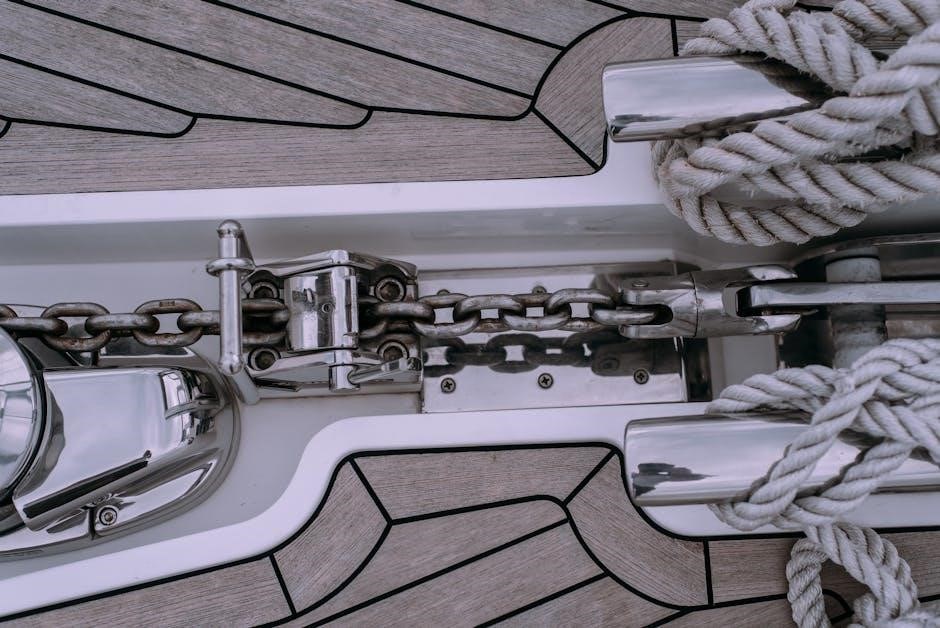
The Twin Cam engine’s primary chain system requires precise tension control to ensure smooth operation․ The manual primary chain tensioner plays a vital role in maintaining optimal chain slack, preventing over-tightening or excessive wear․ Proper adjustment is crucial for longevity and performance, making it a key component in Harley-Davidson’s engine design․ Regular maintenance ensures reduced wear and tear, while incorrect tensioning can lead to premature chain failure․ Understanding its function and importance is essential for any rider or mechanic working on these iconic engines․
1․1 Overview of the Twin Cam Engine
The Twin Cam engine, introduced by Harley-Davidson in 1999, features a revolutionary design with two camshafts, replacing the single camshaft of earlier models․ This innovation improved performance, efficiency, and cooling․ The engine powering iconic models like the Dyna and Softail, it became known for its smooth operation and reduced vibration․ The Twin Cam design incorporates a primary chain system to drive the camshafts, ensuring precise timing and power delivery․ Its enduring popularity stems from its reliability and the ability to customize for enhanced performance․ The engine’s design laid the foundation for advancements in chain tensioning systems, critical for maintaining optimal engine functionality and longevity․
1․2 Importance of the Primary Chain Tensioner
The primary chain tensioner is essential for maintaining proper chain slack in the Twin Cam engine, ensuring smooth power delivery and minimizing wear on critical components․ Incorrect tension can lead to premature chain wear, engine noise, and potential failure․ The manual tensioner allows riders to adjust slack according to riding conditions, preventing over-tightening or excessive looseness․ Proper tensioning enhances engine reliability, reduces maintenance costs, and ensures optimal performance․ By controlling chain movement, the tensioner protects the engine from damage caused by slack or over-tension, making it a vital component for longevity and efficiency in Harley-Davidson’s Twin Cam design․
1․3 Brief History of Chain Tensioners in Harley-Davidson Engines
The evolution of chain tensioners in Harley-Davidson engines reflects advancements in design and functionality․ Early models relied on simple, manually adjusted systems, which required frequent adjustments․ The introduction of the Twin Cam engine in the 1990s brought improved designs, including the manual primary chain tensioner․ This component became crucial for maintaining chain integrity and reducing wear․ Over the years, Harley-Davidson has refined its tensioners to enhance durability and ease of use, with modern versions offering precise control and reliability․ The development of aftermarket options, like the Screamin’ Eagle and Hayden tensioners, further expanded customization and performance capabilities, catering to diverse rider needs and preferences․

Key Concepts and Components
The Twin Cam manual primary chain tensioner ensures proper chain slack, balancing performance and longevity․ It prevents excessive wear and maintains optimal engine function, crucial for smooth operation and durability․
2․1 Primary Chain System Explained
The primary chain system in a Twin Cam engine connects the crankshaft to the camshaft, synchronizing their rotations․ It consists of a chain, sprockets, and tensioners․ The chain rides on sprockets attached to the crankshaft and camshaft, ensuring precise timing․ Proper tension is critical to prevent wear and noise․ The manual tensioner adjusts slack, maintaining optimal chain alignment and reducing stress on components․ Over-tightening can cause premature wear, while too much slack leads to chain slapping․ Regular inspection and adjustment are essential for smooth operation and longevity of the primary chain system․
2․2 Manual vs․ Automatic Chain Tensioners

Manual and automatic chain tensioners serve the same purpose but differ in operation․ Manual tensioners require periodic adjustments by the rider to maintain proper chain slack, ensuring optimal performance and preventing wear․ Automatic tensioners, such as hydraulic or spring-based systems, adjust automatically as the engine runs, eliminating the need for manual intervention․ Manual systems are often favored for their simplicity and durability, while automatic systems offer convenience and consistent tension․ Both types have their pros and cons, with manual tensioners requiring more maintenance and automatic ones potentially being more expensive․ Choosing between them depends on the rider’s preference for ease of use versus hands-on control․
2․3 Components of the Manual Primary Chain Tensioner
A manual primary chain tensioner typically consists of a spring, an adjustment bolt, and a shoe or guide․ The spring applies constant pressure to maintain chain tension, while the adjustment bolt allows for fine-tuning․ The shoe or guide ensures proper chain alignment and prevents wear․ Additionally, some models include locking mechanisms to secure the adjustment in place, preventing unintended loosening․ These components work together to provide a reliable and durable solution for maintaining the primary chain’s integrity․ Regular inspection and maintenance of these parts are essential to ensure optimal performance and prevent premature wear or failure․
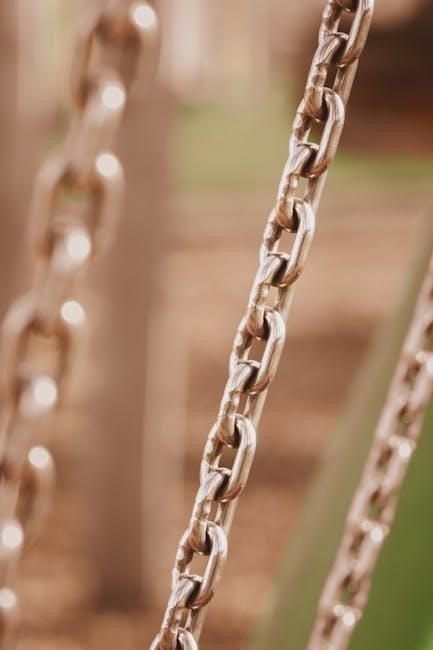
Installation and Adjustment
Installation involves removing the primary cover and aligning the tensioner with the chain․ Adjustment requires loosening the lock nut and turning the tensioner bolt until proper slack is achieved, then securing it firmly to ensure reliable operation and prevent chain wear․
3․1 Tools and Materials Required
To install and adjust the Twin Cam manual primary chain tensioner, you’ll need a socket wrench, Allen wrench, screwdrivers, pliers, and a torque wrench․ Additional tools include a steel ruler for measuring chain slack and a cleaning brush for debris removal․ Materials required are a new primary cover gasket, cam plate O-rings, and chain lube․ Ensure all components are compatible with your specific Harley-Davidson model․ Having these tools and materials ready ensures a smooth and efficient process, preventing potential damage to the engine or chain system during installation and adjustment․ Proper preparation is key to maintaining your bike’s performance and longevity․
3․2 Step-by-Step Installation Guide
Begin by removing the primary cover using a socket wrench and Allen wrench․ Disconnect the chain and take out the old tensioner․ Inspect and clean the area thoroughly․ Install the new manual tensioner, ensuring proper alignment with the chain․ Tighten the bolts gradually, following the recommended torque specifications․ Reattach the chain, adjusting its slack as needed․ Reinstall the primary cover, replacing the gasket to ensure a leak-free seal․ Double-check all connections and tighten any loose bolts․ Finally, test the system by starting the engine and observing chain movement․ Always consult the service manual for specific torque values and alignment details to ensure a safe and proper installation․
3․3 Adjusting the Tensioner for Optimal Performance
Adjust the manual primary chain tensioner by turning the adjustment screws until the chain achieves the recommended slack․ Use a screwdriver to tighten or loosen the screws, ensuring even tension․ Over-tightening can lead to premature wear, while excessive slack may cause chain slapping noise․ Check the chain periodically, especially after initial installation, to maintain proper tension․ Ride the bike gently for a few miles to settle the chain, then readjust as needed․ Always refer to the service manual for specific torque values and adjustment guidelines․ Proper adjustment ensures quiet operation, reduces wear, and extends the life of both the chain and tensioner․
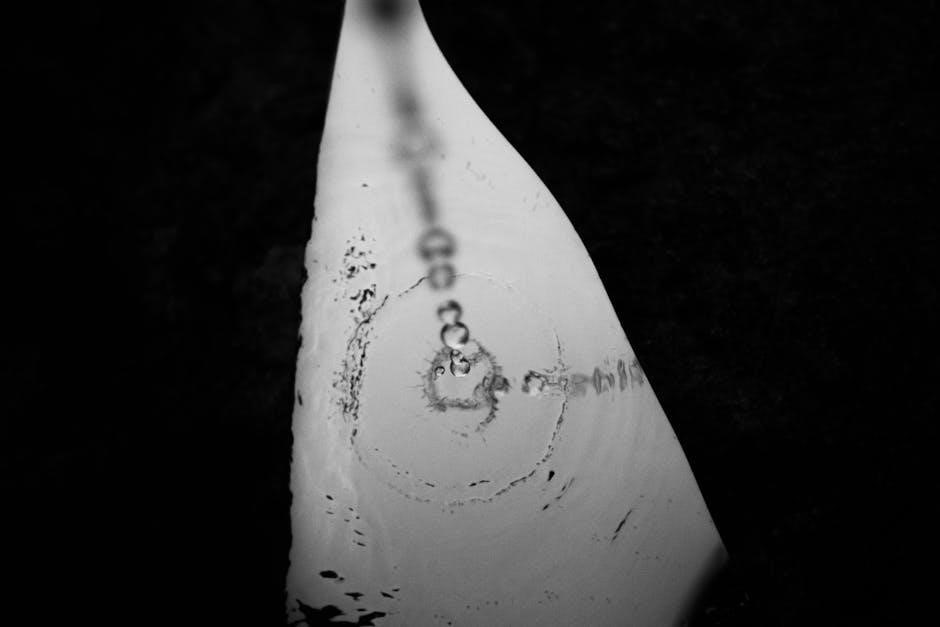
Symptoms of a Faulty Tensioner
A faulty tensioner can cause chain slapping noise, excessive vibration, or uneven chain wear․ It may also lead to over-tightening or loose chain conditions, affecting engine performance․
4․1 Common Issues with Manual Tensioners
Manual tensioners often face challenges like over-tightening, leading to premature chain wear․ Improper slack adjustments can cause chain slapping noise or excessive vibration․ Additionally, worn-out springs or incorrect installation may result in inconsistent tension, affecting engine performance․ Riders might also experience difficulties in maintaining the correct tension during extreme riding conditions․ Regular inspection and precise adjustments are essential to prevent these issues․ Overlooking these problems can lead to costly repairs, emphasizing the need for meticulous maintenance and adherence to manufacturer guidelines․
4․2 Signs of Worn or Loose Chain Tension
A worn or loose primary chain tensioner can manifest through several noticeable symptoms․ Audible signs include a slapping or rattling noise from the primary chain area, indicating excessive slack․ Visually, the chain may appear to bounce or vibrate excessively during operation․ Over time, this can lead to uneven chain wear and potential damage to surrounding components․ Performance-wise, riders might experience reduced power delivery or a “jerky” feel during acceleration․ If left unaddressed, these issues can escalate, causing premature wear on the chain and tensioner system․ Regular inspections are crucial to identify and resolve these problems before they lead to more severe mechanical failures․
4․3 Diagnostic Steps for Identifying Problems
Diagnosing issues with the manual primary chain tensioner involves a systematic approach․ Start with a visual inspection of the chain and tensioner for signs of wear or misalignment․ Check the chain for excessive slack or tight spots by manually pressing it downward; it should have minimal give․ Listen for unusual noises, such as slapping or rattling, which indicate improper tension or worn components․ Measure the chain tension using the specified tool or method outlined in the service manual․ Inspect the tensioner springs for weakness or damage, as they are critical for maintaining proper chain slack․ Finally, test the bike under various conditions to replicate any issues, ensuring accurate troubleshooting and repair․

Maintenance and Care
Regular inspections ensure optimal performance․ Lubricate with high-quality oils like BelRay or Amsoil․ Clean the chain and tensioner to prevent wear․ Replace worn parts promptly for reliability․
5․1 Regular Inspection Checklist
A thorough inspection ensures the primary chain tensioner’s longevity․ Check for chain wear, tensioner spring condition, and proper alignment․ Look for signs of excessive slack or tightness․ Inspect the primary cover gasket for leaks and ensure all bolts are tightened to specifications․ Lubricate the chain and tensioner as recommended․ Visually inspect the primary chain for rust or damage․ Replace any worn components immediately․ Regular checks prevent unexpected failures and maintain optimal engine performance․ Keep a maintenance log to track inspections and replacements․ Addressing issues early avoids costly repairs and ensures smooth operation․
5․2 Lubrication and Cleaning Practices
Regular lubrication is essential for the longevity of the primary chain and tensioner․ Use a high-quality chain lube, applying it evenly to both sides of the chain․ Wipe off excess lube with a clean cloth to prevent dirt accumulation․ Clean the chain with a soft-bristle brush to remove grime and debris․ Avoid using harsh detergents or high-pressure washes, as they can damage the chain or tensioner․ For stubborn dirt, a mild solvent can be applied, but ensure the chain is dry before re-lubricating․ Keep the tensioner free from contaminants by wiping it with a clean cloth․ Proper lubrication and cleaning practices extend the life of the chain and tensioner, ensuring smooth operation and preventing premature wear․
5․3 When to Replace the Tensioner or Chain
Replace the tensioner or chain when visible wear, stretching, or damage is evident․ If the chain is rusted, has broken links, or exceeds the wear limit, replacement is necessary․ A chain wear indicator tool can help measure stretch․ The tensioner should be replaced if it no longer holds correct tension or shows signs of wear․ Address issues like chain slapping noise promptly, as it may indicate a loose chain․ Follow the manual’s recommended inspection schedule and replace parts based on mileage and usage․ Ensure compatibility when replacing, such as using a 530 series chain for Twin Cam engines․ Proper maintenance, including cleaning and lubrication, can extend lifespan, but replacement is needed when wear is irreversible․ Always follow torque specifications and adjustment procedures for optimal performance․
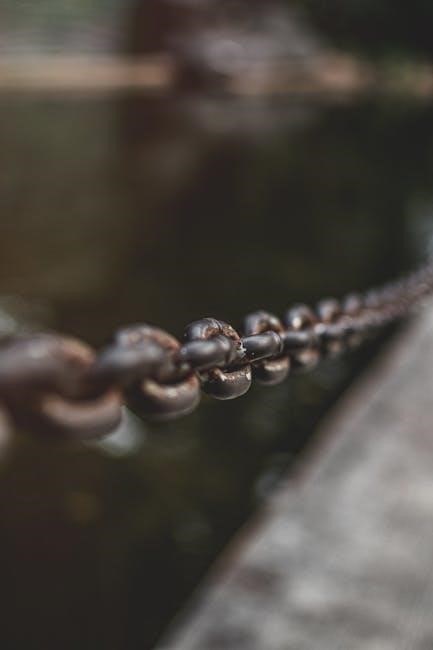
Case Studies and Real-World Applications
Real-world applications highlight the Twin Cam manual primary chain tensioner’s reliability․ Riders report improved performance and reduced wear with aftermarket options like Screamin’ Eagle and Hayden tensioners․
6․1 Screamin’ Eagle Manual Primary Chain Tensioner
The Screamin’ Eagle manual primary chain tensioner is a high-performance upgrade for Twin Cam engines․ Designed by Harley-Davidson, it offers precise control over chain tension, reducing wear and noise․ Riders praise its durability and ease of adjustment, making it a preferred choice for enthusiasts․ With its robust construction and spring-loaded design, it ensures consistent tension, enhancing engine smoothness and reliability․ This aftermarket solution is ideal for those seeking improved performance and longevity from their primary chain system․
6․2 Hayden Primary Chain Tensioner Review
The Hayden primary chain tensioner is a popular aftermarket solution for Twin Cam engines, known for its reliability and performance․ Designed with a spring-loaded mechanism, it maintains consistent chain tension, reducing noise and wear․ Riders appreciate its durability and ease of installation, making it a favorite among enthusiasts․ The Hayden tensioner is particularly praised for its ability to minimize chain slap and provide a quieter ride; While some users note it requires careful adjustment, the overall consensus is positive, with many considering it a worthwhile upgrade for improved engine smoothness and longevity․
6․3 User Experiences and Feedback
Users of the Twin Cam manual primary chain tensioner have shared diverse experiences, highlighting both benefits and challenges․ Many riders praise its simplicity and effectiveness in maintaining proper chain tension, which reduces wear and noise․ Some enthusiasts mention that regular adjustments are necessary to prevent over-tightening, which can lead to premature component failure․ Others appreciate the cost-effectiveness and ease of installation compared to automatic models․ However, a few users note that achieving the perfect tension can be tricky, requiring patience and precise technique․ Overall, the feedback underscores the importance of proper maintenance and adjustment to maximize performance and longevity․

Troubleshooting Common Issues
Chain slapping noise often indicates improper tension or worn components․ Over-tightening can damage the chain or sprockets, while loose tension may cause excessive wear․ Regular inspection and adjustment are essential to maintain optimal performance and prevent costly repairs․
7․1 Chain Slapping Noise: Causes and Solutions
A chain slapping noise in the primary chain system is often caused by excessive chain slack or improper tension․ This occurs when the manual tensioner is not adjusted correctly, allowing the chain to move excessively․ Over time, this can lead to premature wear on the chain, sprockets, and tensioner components․ To resolve this, ensure the chain tension is set to the manufacturer’s specifications․ Regular inspections and adjustments are crucial to maintain optimal tension and prevent noise․ If the issue persists, consider upgrading to a high-quality aftermarket tensioner, such as the Hayden model, which is known for reducing chain slap and improving system stability․
7․2 Over-Tightening and Its Consequences
Over-tightening the manual primary chain tensioner can lead to increased wear on the chain, sprockets, and tensioner components․ Excessive tension causes unnecessary stress on the system, potentially resulting in premature failure of the chain or sprocket teeth․ Additionally, over-tightening can lead to reduced chain life and increased heat generation, which may cause component damage․ It is crucial to follow the manufacturer’s torque specifications and adjust the tensioner carefully․ Regular inspections and proper adjustment techniques can prevent over-tightening and ensure optimal performance․ Always refer to the service manual for guidance on correct tensioning procedures to avoid these costly and avoidable issues․
7․3 Adjusting for Different Riding Conditions
Adjusting the manual primary chain tensioner for various riding conditions ensures optimal performance and longevity․ In high-speed or heavy-load conditions, tighter tension may be necessary to prevent excessive slack and potential chain slap․ Conversely, in stop-and-go traffic or lighter loads, slightly looser tension can reduce wear on components․ For off-road or aggressive riding, maintaining the correct tension balance is critical to avoid chain derailment or premature wear․ Always refer to the manufacturer’s guidelines for specific adjustments based on riding conditions․ Seasonal temperature changes can also affect chain tension, requiring periodic checks․ Proper adjustments ensure smooth operation, reduced noise, and extended component life across all riding scenarios․
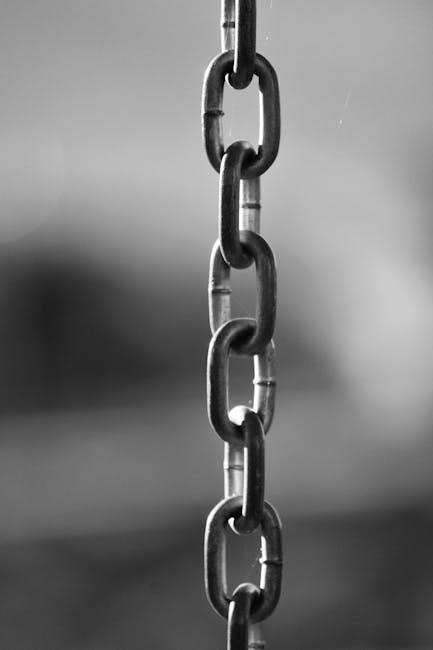
Upgrades and Modifications
Upgrading to aftermarket tensioners like Screamin’ Eagle or Hayden enhances performance and durability․ High-performance chains and custom primary systems offer improved strength and quieter operation for demanding riders․
8․1 Aftermarket Tensioner Options
Aftermarket tensioners, such as the Screamin’ Eagle Manual Primary Chain Tension Adjuster (part #36500020), offer enhanced durability and reliability․ These upgrades are designed to improve performance and reduce noise․ Hayden tensioners, known for their spring-tensioned design, allow for tighter chain control and a quieter primary system․ High-performance chains, like those with reinforced rollers, provide superior strength and longevity․ Customizable solutions cater to specific riding styles, ensuring optimal performance․ Upgrading to these components is a popular choice among enthusiasts seeking improved functionality and reduced maintenance․ These options are engineered to withstand the demands of high-mileage and heavy-duty use, making them a worthwhile investment for Twin Cam owners․
8․2 Upgrading to a High-Performance Chain
Upgrading to a high-performance chain enhances the durability and efficiency of your Twin Cam engine․ Chains like the 530 series are popular for their strength and reliability․ High-performance chains feature advanced materials and designs, such as reinforced rollers and heat-treated components, to withstand heavy use․ They reduce wear on the primary system and provide smoother operation․ Upgrading is recommended when replacing the tensioner or during routine maintenance․ These chains are ideal for high-mileage riders or those seeking improved performance․ Ensure compatibility with your engine specifications and consult a mechanic for proper installation to maximize benefits and ensure safety․
8․3 Customizing the Primary Chain System
Customizing the primary chain system allows riders to tailor their Twin Cam engine’s performance to specific needs․ Aftermarket components, such as billet covers and adjustable tensioners, offer enhanced functionality and aesthetics․ Riders can choose from various chain types, including lightweight options for improved power delivery or heavy-duty chains for durability․ Customization may also involve upgrading sprockets or adding decorative finishes․ Proper installation by a skilled mechanic is crucial to maintain system integrity․ These modifications not only boost performance but also add a personal touch to the bike․ Always ensure compatibility with existing components and follow manufacturer guidelines for optimal results and reliability․
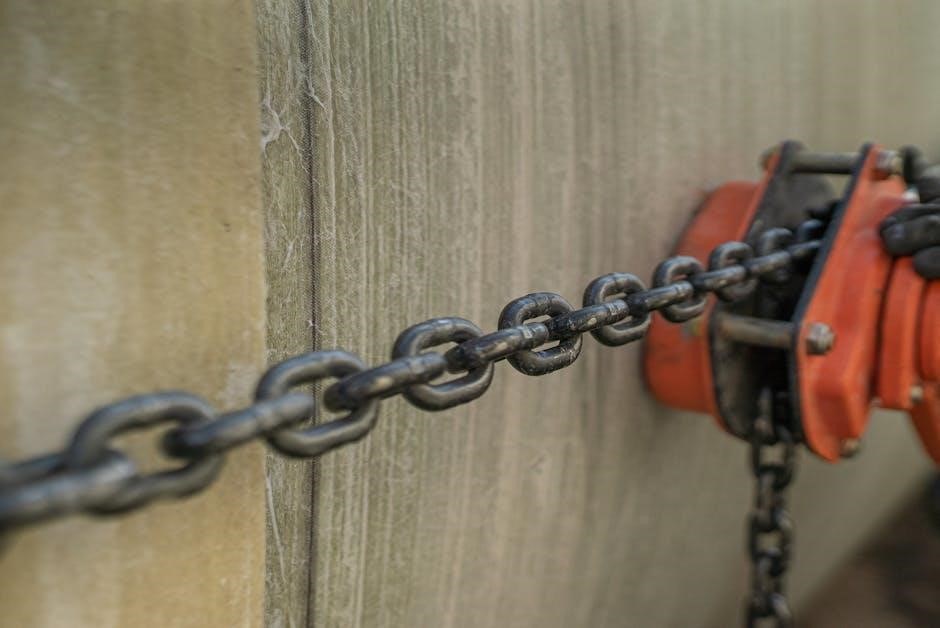
Safety Precautions and Best Practices
Always wear protective gear and ensure the bike is securely supported․ Use proper tools and follow manufacturer guidelines to avoid accidents․ Regular inspections and adjustments are crucial for safe operation and longevity․
9․1 Essential Safety Tips for Handling Chains
Always wear protective gear, including gloves and safety glasses, when handling chains․ Ensure the motorcycle is on a stable stand to prevent accidental movement․ Use proper tools designed for chain adjustments to avoid slippage or injury․ Regularly inspect chains for wear or damage and replace them if necessary․ Lubricate chains appropriately to prevent overheating and extend lifespan․ Never tighten chains excessively, as this can lead to premature wear or breakage․ Keep loose clothing tied back and avoid wearing jewelry that could get caught․ Always refer to the manufacturer’s guidelines for specific safety precautions․ Stay alert and cautious when working near moving parts or under tension․
9․2 Preventative Measures to Avoid Accidents
Regularly inspect the primary chain and tensioner for wear or damage to prevent sudden failures․ Always follow the manufacturer’s maintenance schedule to ensure optimal performance․ Use proper tools and techniques when adjusting the tensioner to avoid over-tightening or under-tightening, which can lead to chain failure․ Keep the chain lubricated to reduce friction and wear․ Store the motorcycle in a clean, dry environment to prevent rust or corrosion․ Avoid riding aggressively if the chain is showing signs of wear․ Consider replacing the chain and tensioner if they are nearing the end of their service life․ These steps help ensure safe and reliable operation․
9․3 Proper Tools and Techniques for Adjustments
When adjusting the manual primary chain tensioner, use a torque wrench and Allen key for precise adjustments․ Start by loosening the locknut slightly, then turn the adjuster to achieve the correct tension․ Tighten the locknut firmly to secure the setting․ Always refer to the service manual for specific torque specifications․ Proper technique ensures the chain runs smoothly and prevents damage․ Regular practice helps develop muscle memory for accurate adjustments․ Using the right tools and following the correct procedure guarantees optimal performance and longevity of the chain and tensioner․ Proper adjustment is key to maintaining the integrity of the primary chain system․
The Twin Cam manual primary chain tensioner is essential for maintaining engine performance․ Proper maintenance ensures longevity and prevents costly repairs․ Future advancements promise improved efficiency and durability․
10․1 Summary of Key Points
The Twin Cam manual primary chain tensioner is a critical component for maintaining engine performance and longevity․ Proper installation, adjustment, and regular maintenance are essential to prevent chain wear and engine damage․ Signs of a faulty tensioner include chain slapping noises, excessive slack, or over-tightening, which can lead to premature wear․ Regular inspections, lubrication, and timely replacements are vital for optimal functionality․ Understanding the differences between manual and automatic tensioners, as well as their components, ensures better troubleshooting and maintenance․ By following best practices and staying informed about upgrades, riders can enhance their engine’s reliability and performance over time․
10․2 Importance of Proper Maintenance
Proper maintenance of the Twin Cam manual primary chain tensioner is crucial for ensuring the longevity and efficiency of the engine․ Regular inspections help identify worn or loose components, while lubrication prevents corrosion and friction․ Cleaning the chain and tensioner regularly removes dirt and debris that can cause premature wear․ Adjusting the tensioner correctly prevents over-tightening, which can damage the chain and sprockets․ Neglecting maintenance can lead to costly repairs, such as replacing the entire chain or tensioner assembly․ Consistent upkeep not only enhances performance but also ensures a safer and more reliable riding experience for Harley-Davidson enthusiasts․ Timely maintenance is essential for optimal functionality․
10․3 Future Developments in Chain Tension Technology
The future of chain tension technology is expected to focus on automation and intelligent systems․ Innovations like self-adjusting tensioners with sensors could monitor chain slack in real-time, ensuring optimal tension without manual intervention․ High-performance materials, such as advanced alloys and coatings, may enhance durability and reduce wear․ Additionally, integrations with engine management systems could provide real-time feedback to riders․ Companies like Screamin’ Eagle and Hayden are already leading the way in developing quieter, more efficient tensioners․ These advancements aim to improve reliability, reduce maintenance needs, and enhance overall riding performance for Harley-Davidson enthusiasts․ Such innovations will likely become standard in future Twin Cam engines․